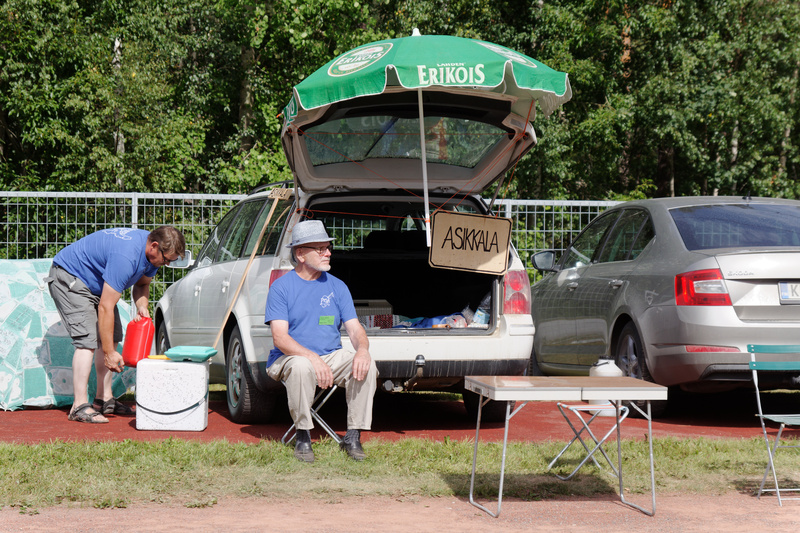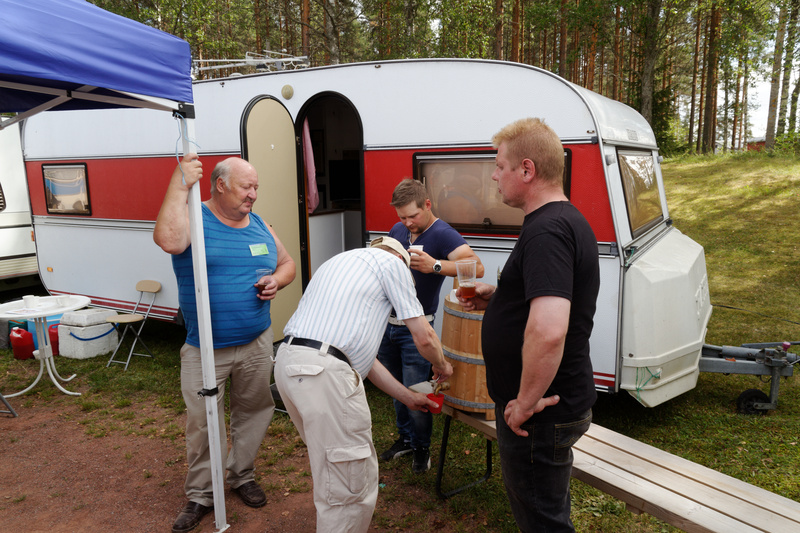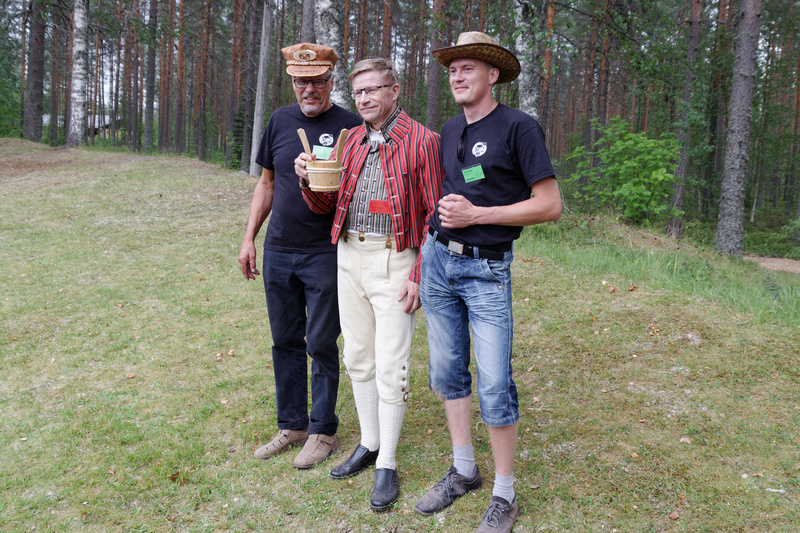The sahti championship in Karvia

The site of the 2018 Finnish sahti championship |
A large, empty sports field, with some cars parked round the edge. That really was what we were seeking in Karvia, a village way out in the Finnish countryside. The nearest town of any size was Pori, about 80km to the southeast. The field was the site of the annual Finnish national championship in sahti brewing. We had decided to stop by, because it seemed like a great opportunity to try a number of different sahtis. (This was part of the Finnish sahti expedition of 2018.)
Finnish farmhouse brewers are unique in that they have organized themselves through the Finnish sahti brewers association. One of the things this organization does is to arrange an annual sahti brewing competition. The championship has two "rounds". In the first round, the local sahti association chapters in each municipality judge the local beers and choose one sahti to represent their municipality.
The second "round" is the one we attended, where the brewers bring their beer to the national championship. Each municipality sends one judge, and the expectation in each municipality is that their judge should recognize their local beer and vote for that. People who have been judges told me that this is impossible and you end up voting for what you think is the best beer. While judging goes on the brewers set up somewhere nearby and serve beer for free to anyone who wants to try it. The local sahti association chapter usually also sells some food and non-alcoholic drinks.

Brewer from Asikkala municipality ready to serve sahti |
The event started at noon, and the start was marked basically by people opening the trunks of their cars to reveal coolboxes containing sahti. It felt more than a little weird to walk up to these people with an empty glass and a hopeful expression on my face, unsure of whether they spoke any English at all. It was soon clear that many of them did not speak English, but the universal gesture with the empty glass was understood by everyone.
This was actually my first taste of real, homebrewed sahti from traditional brewers, so once I had the first glass I withdrew to taste it properly and take notes. An empty sports field is not a great place for note-taking with a beer in your hand, but I managed to find a fence with a flat metal top where I could put my beer.
My first sahti was brewed by Jussi Saren, from Orimattila, far to the southeast of Karvia. A hazy, deep yellow beer, sweet, low carbonation, some alcohol aroma. Definite flavour of both juniper and raw ale, with the thick, viscous texture that's so characteristic of sahti. I did manage to quiz him a little about the beer, and he said he thought it was about 10%, a fairly typical strength for sahti. He'd made a few changes to the tradition, so he was now using juniper berries rather than branches. But then he wasn't born into the tradition: he learned to brew from a neighbour.

Real sahti. Pretty strong, too. |
I kept trying to strike up conversations, but didn't really get anywhere. The Finns are normally not very talkative when sober, and many of the older generation speak little English, which makes it even harder. So I focused on trying the sahtis instead.
The next one was darker and sweeter, definitely also very strong. Then I found a brewer who could tell me a little: he used juniper infusion and juniper branches as a filter. His beer was drier, and very good. No hops at all. Every brewer so far had told me the same thing: they used half a kilo of malt per liter of beer.
As the day wore on, drinking 8-10% beer eventually had the expected effect on the Finns: they started opening up and becoming talkative.

Sahti being served from a wooden cask |
One guy told me that he had family in eastern Finland who had brewed oven-based farmhouse ale, called taari. Unfortunately, he didn't have any recipes or any more details.
Several people claimed that out in the countryside some of the sahti brewers sell their beer illegally, and that this trade is of considerable proportions. Some of the illegal brewers sell as much as 50'000 liters a year, they claimed. Even though it's illegal the locals tend to quietly accept it, and usually there is a code of honour involved. No selling to under-age drinkers, for example.
In parts of western Norway the locals have also at times been selling the farmhouse ale, although I'm not sure if anyone has done it over the last decade. And I don't think any of them produced this much beer.
It was clear that winning this championship was something that people noticed, and the winners had high status. Several times people referred to the winner of this or that year. There was also some talk of last year's winner, who was unusually young, at the age of 22. The winner each year gets a traditional birch bark hat with the sahti society logo, and the inscription "sahti champion year".

Olavi Viheroja, 2010 champion. |
One brewer was spoken of with particular reverence: Olavi Viheroja, the 2010 champion. We had actually been invited to brew with him a couple of days later. When I told the Finns this one of them turned, looked me in the eye, and said with emphasis "I hope you appreciate the honour." "Sure," I mumbled, a little taken aback.
Another recurring theme was people expressing concern that the championship was somehow distorting sahti brewing. It was claimed that some people brew their normal beer for the local municipality championship, then a different beer for the national championship. In the national championship the judges supposedly prefer darker beers, so people deliberately pick a darker malt bill for that competition. Several people claimed that sahti was generally getting darker under the supposed influence of the national judges.
Then, suddenly, there was a commotion at the end of the field where the judges were working and the locals were selling food. Apparently the judges were going to announce the winner. Everyone streamed over to that side of the field, to listen to someone speaking in Finnish. To us foreigners it was clear they were announcing the results, but beyond that we couldn't make out anything.
The moment the announcer was finished, people headed off at speed across the field. I watched them in puzzlement until it was explained to me that everyone of course wanted to taste the winner's beer. This year's winner was Kari Harju, which was lucky for us. He comes from a place near Isojoki, where we were going the next day, so we could meet him there and ask him questions.

Left to right: Kari Harju, the 2018 champion, already wearing his hat. Pekka Kääriäinen, chairman and founder of the sahti society. Kari's son, whose name I sadly forgot to note. |
Everyone gathered around Kari's stand, drinking and chatting excitedly. And then it was over, at seven o'clock in the afternoon. People quietly dispersed, everyone heading in a different direction.
Similar posts
At the Sahti Academy
One of the most notable stands at the sahti championship belonged to the so-called Sahti Academy (Sahtiopisto), an association of sahti brewers in the small town of Isojoki, who have joined forces to promote their sahti brewing heritage
Read | 2021-01-11 19:53
Brewing with Olavi the champion
We drove along dirt roads through seemingly empty forest for half an hour, the dust curling lazily behind us
Read | 2021-05-22 13:26
The great Finnish sahti expedition
As farmhouse ale styles go sahti is quite well documented in print, but if you really want to understand a kind of beer there is no other way than to go there
Read | 2020-09-20 10:56
Comments
John Horn - 2020-09-28 23:44:14
I'm enjoying these stories. Looking forward to more.
Nick Trausch - 2020-11-07 02:09:22
Our homebrew club made Sahti as a project a few years ago. Had a great time and we thought a nice result. We were inspired by the late great Michael Jackson of the UK and another article in Zymurgy magazine. These blogs inspire thoughts of trips to Norway and Finland and future homebrews also.